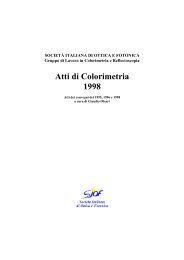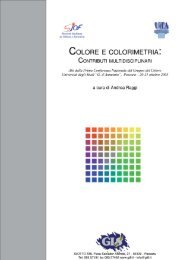Scarica gli atti - Gruppo del Colore
Scarica gli atti - Gruppo del Colore
Scarica gli atti - Gruppo del Colore
Create successful ePaper yourself
Turn your PDF publications into a flip-book with our unique Google optimized e-Paper software.
espect to the unknown spectrum under the given illuminant and with the given<br />
observer, it may exhibit poor colorimetric matching with a different illuminant or<br />
observer, indicating that the underlying spectral match required has not been<br />
obtained. Since the spectral matching cannot be addressed directly, a method that<br />
allows the synthesis of a surface reflectance spectrum by taking into account<br />
colorimetric information referred to different illumination or observation<br />
conditions can increase the similarity between the estimated and the unknown<br />
reflectance spectrum.<br />
We have applied genetic algorithms to formulate the problem of reflectance<br />
estimation for the simultaneous optimization of several constraints. We have also<br />
investigated, in the framework of the proposed method, the performance of<br />
different basis sets for reflectance function representation.<br />
In Section 2 we provide a formal formulation of the problem addressed. Section 3<br />
describes the basis functions considered here, while Section 4 is a brief overview of<br />
the genetic algorithm proposed. The performance of the algorithm and of the basis<br />
functions is examined in Section 5, where standard datasets are used for<br />
benchmarking.<br />
2. Problem Formulation<br />
A color stimulus is related to the CIE XYZ tristimulus values by the following<br />
equations:<br />
∫<br />
X = K R(<br />
λ) I(<br />
λ)<br />
x(<br />
λ)<br />
dλ<br />
λ<br />
∫<br />
Y = K R(<br />
λ) I(<br />
λ)<br />
y(<br />
λ)<br />
dλ<br />
(1)<br />
λ<br />
∫<br />
Z = K R(<br />
λ) I(<br />
λ)<br />
z(<br />
λ)<br />
dλ<br />
λ<br />
where R(λ) is the reflectance spectrum, I(λ ) is the illuminant’s spectral power<br />
distribution, x (λ)<br />
, y (λ)<br />
and z (λ)<br />
are the color matching functions that define the<br />
CIE 1931 standard colorimetric observer. If the reflectance function is represented<br />
in the range of [0,1], and a luminance of 100 is attributed to the light source in the<br />
scene, then the normalization factor K is:<br />
K =<br />
∫<br />
λ<br />
100<br />
I(<br />
λ) y(<br />
λ)<br />
dλ<br />
Equation (1) indicates that an infinite number of different reflectance functions<br />
may generate the same tristimulus values. The reflectance function may be<br />
expressed through a linear mo<strong>del</strong> as a weighted sum of a set of basis functions:<br />
(2)<br />
149





